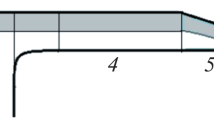Abstract
Physical modeling of a ventilated cavity with a negative cavitation number has shown that at the same flow rate and head parameters different cavitation-induced self-oscillation patterns can be realized. The generation of these patterns depends on the feeding pipeline parameters. The high-speed videofilming shows that the physics of the process are the same in different frequency regimes, the wave propagation velocity in the jet flow is mainly determined by the cavitation number, and the difference between self-oscillation patterns is characterized by the number of the waves along the cavity length. A method of estimating the self-oscillation frequencies from the given flow geometry and the cavitation number is proposed.
Similar content being viewed by others
References
I. I. Kozlov and V. V. Prokof’ev, “Gas Entrainment from a Ventilated Cavity with a Negative Cavitation Number,” Fluid Dynamics 36 5, 751 (2001).
I. I. Kozlov, V. V. Prokof’ev, and A. A. Puchkov, “High-Speed Videocamera Investigation of the Wave Structure Development on an Unstable Cavity Boundary,” Fluid Dynamics 43 2, 287 (2008).
I. I. Kozlov, S. A. Ocheretyanyi, and V. V. Prokof’ev, “Experimental Investigation of Liquid Jet Outflow into a Plane Ventilated Channel in Self-Oscillatory Regimes,” Fluid Dynamics 46 4, 548 (2011).
A. N. Khomyakov and R. A. Shumilov, “A Technique of Improving the Thrust Parameters ofWater-Jet Propellers,” in: Collection of the Reports of the International Conference Devoted to the 75th Anniversary of Academician V. A. Levin. September 28–October 4, 2014 [in Russian], Institute of Mathematics and Mechanics of the Far East Division of the Russian Academy of Sciences, Vladivostok (2014), p. 498.
V. V. Pilipenko, Cavitation-Induced Self-Oscillations [in Russian], Naukova Dumka, Kiev (1989).
I. I. Kozlov, S. A. Ocheretyanyi, and V. V. Prokof’ev, “Self-Oscillation Regimes in a Liquid Jet Curtain Separating Gas Regions with Different Pressures,” Fluid Dynamics 48 6, 738 (2013).
E. B. Gartig and I. G. Blagoveshchenskii, “Applied Problems of the Liquid Flow Dynamics in a Pipeline with a Bounded Artificial Gas Cavity,” Vestn. Nizhnii Novgorod Gos. Univ. No. 4(3), 705 (2011).
P. M. Shkapov, I. G. Blagoveshchenskii, E. B. Gartig, and S. A. Doroshenko, “Hysteresis Nature of the Self-Oscillation Development in a Hydraulic Line with a Bounded Artificial Gas Cavity at the Exit,” Nauka Obrazovanie (Electronic Edition) No. 10 (2013).
S. Ya. Gertsenshtein, V. M. Chernyavskii, and Yu. M. Shtemler, “Asymptotic Stage of the Rayleigh–Taylor Instability,” Dokl. Akad. Nauk SSSR No. 4, 819 (1989).
Author information
Authors and Affiliations
Corresponding author
Additional information
Original Russian Text © I.I. Kozlov, S.A. Ocheretyanyi, V.V. Prokof’ev, 2016, published in Izvestiya Rossiiskoi Akademii Nauk, Mekhanika Zhidkosti i Gaza, 2016, Vol. 51, No. 2, pp. 32–43.
Rights and permissions
About this article
Cite this article
Kozlov, I.I., Ocheretyanyi, S.A. & Prokof’ev, V.V. Effect of the feeding pipeline properties on the nature of cavitation-induced self-oscillations in the presence of a ventilated cavity with a negative cavitation number in the system. Fluid Dyn 51, 155–166 (2016). https://doi.org/10.1134/S0015462816020046
Received:
Published:
Issue Date:
DOI: https://doi.org/10.1134/S0015462816020046



